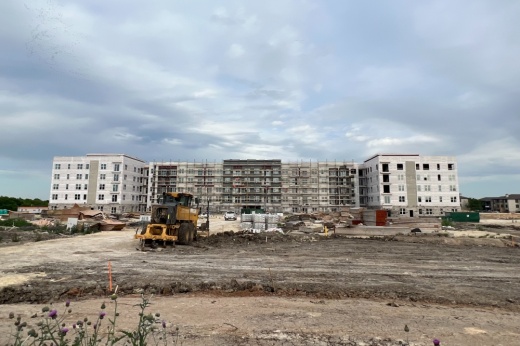Two-minute impact
Jordan Brooks, a senior market analyst with national and local apartment data collector ALN Apartment Data, said Austin’s multifamily unit supply is set to remain high through at least 2024.
Austin ranks eighth in the country for cities with the most new units under construction. As of September in Austin, there were:
- 63,882 units under preconstruction
- 41,071 units under construction
- 10,124 units under lease-up, or being filled
- 17,364 units under construction/lease-up
As projects started between 2021-24 reach completion and introduce a high supply of housing to the market, Brooks said there will likely be a reduction in construction activity by 2025 or 2026.
While recent construction deliveries have helped ease rent prices over the last few years, Brooks said it’s also hard to predict how prices will pan out in the coming years due to demand.
“We’re in this period right now of kind of prolonged stubbornly low apartment demand,” Brooks said. “There’s so much up in the air right now in terms of the economy, but certainly over the next six or nine months it’s hard to see how occupancies are going to bounce back in a positive direction. If that doesn’t happen, then it’s hard to see how rent growth would really reverse course either.”
How we got here
Brooks said between 2010-15, Austin was “well above” the national rent growth average. During that time, the average number of new multifamily units brought to the market was around 5,000. There have already been over 15,000 units delivered so far this year.
While Austin continues to be a “strong migration city” with a “robust, diversified job market,” the demand has still slowed. There are about 36,000 vacant multifamily units in the Austin metro area, a number Brooks said could rise in the coming months as the demand is usually lower during winter and spring.
“I think a decent rebound in demand would be in spring 2024, but that’s going to depend on what the state of the economy is at that time,” Brooks said. “What’s the state of the labor market? What has the impact been of the student loan payments restarting, which will have been going for a few months at that time?”
Fewer projects in the pipeline could also be a result of lowered demand.
“It’s hard to say that [builders] won’t start responding as they see rents flatten out,” said Adam Perdue, a research economist at the Texas Real Estate Research Center. “[Prices] are still higher than we expected them to be in 2019, and so that’s still some incentive to continue to build apartments, which is being pushed back with the high interest costs right now.”
What’s next?
For now, Brooks said there is still a “very active construction pipeline” through 2025, something that will continue to play a role in the coming years even as new construction begins to dwindle. As such, it will be a few years before residents are likely to feel any effects on rent.
“The [construction] starts in 2024 and 2025 are going to be coming into the market in 2025, 2026 or early 2027,” Brooks said. “Then, it takes another almost year and a half on average to lease those properties up. ... You’re going to have this whole period where delivery might slow down in a few years, but you’re still absorbing all of the units from the last five years that have come in. I think that the current scale of the construction pipeline is sufficient to keep significant pressure off of rent until at least 2024.”
Perdue added while a slower pace of construction starts is to be expected as rents stabilize, it’s hard to tell what that will mean for future prices.
“We still have a lot of under-construction units, which are definitely—as those are delivering—helping to ease rent,” Perdue said. “In real estate, you can sometimes see what appears to be these booms and busts that have rents going in the opposite direction, but to me, that’s not actually incredibly apparent in the data yet.”





